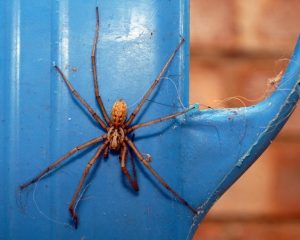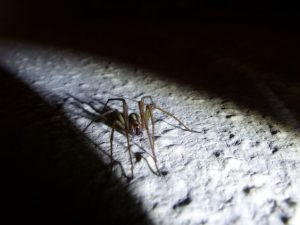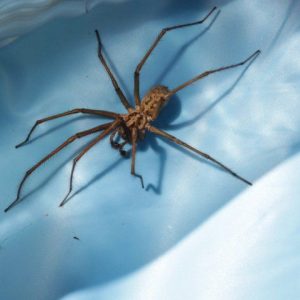Citizen science describes projects whereby members of the public work with researchers to provide useful and interesting scientific data. In the last five years or so, the approach has seen a big growth in all sorts of areas of science.
It was late February 2012 that Becky Nesbit, formerly the press officer of what was then the Society of Biology, emailed me about starting up a citizen science project.
The idea was for the project to run across the summer, with the aim of rising public awareness for the first Biology Week that would run in October – and of course to find out something new and interesting!
That email conversation became the Flying Ant Survey, which ran for three years, producing a whole wave of good flying ant news stories and, after rather a lot of number crunching with my colleague Anne Goodenough, publication of a scientific paper.

A Tegenaria spp. specimen, one of the species people could use the app to help identify
Flushed with the success of this first project, Becky and I started to think about running a second in 2013…but what should be our focus? Well, given we were discussing this in October and I was currently under siege from another wave of house spiders, it wasn’t a difficult decision.
Every autumn “spider season” predictably brings spiders in to our homes. We know that these are often males searching for females, and we also know that they seem to appear around September and disappear by November, but there was a lot we didn’t know especially at a national level. What proportion of sightings are males? Is there a pattern to spider sightings across the country as autumn proceeds? For how long does spider season last for? Where in our homes are we most likely to see spiders? When during the day is the peak time for sightings?
To answer those questions we decided that we needed an app.
The “Spider in da House” app was developed quite quickly and was a mix of some information about spiders in general, more detailed information on the species you are likely to see in your house, and a data collection function that allowed people to input their sightings via the app to our database. We had expected a bit of interest, and perhaps a few thousand downloads. We had not expected quite the wave of publicity that we got!
Through some savvy promotion, we were able to get across a far more positive message about the beauty and value spiders, discussing their ecological significance and importance. App downloads really hit their stride, with tens of thousands reaching for their phones as stories appeared in newspapers up and down the UK, and more and more people became invested in finding out more about these stealthy visitors.

Citizen scientists up and down the country started logging where they were spotting these unwelcome visitors and when
In the end, we gathered more than 10,000 usable data entries detailing sightings, exact location, date and time, location within the house, sex and much else besides.
Citizen scientists from across the UK were incredibly generous with their data and, as with the flying ant study, Anne, Becky and I were suddenly faced with a rather large amount to work to do with all those numbers!
Now, five years later, we have published these findings in the journal Arachnology, to share with the world what we’ve found.
What the numbers showed us was that spider season comes to a peak in mid to late September, but the main wave only lasts for a couple of weeks. Around 7.30pm was the peak time for sightings of the house spiders from the genera Tegenaria and Eratigena.
Using the recordings of where people were spotting these spiders in the house, we were able to show that the time probably reflects spider activity rather than our inactivity (slumped on the sofa in the living room and potentially more likely to see spiders).
More than 80% of sightings were males, and males and females differed in their “house ecology”, with males more likely to be seen on walls. The living room was the most likely place to see a spider and by comparing sightings between rooms and with time of day we are reasonably confident that our findings don’t just reflect room useage.

The project helped many realise that spiders are a lot more helpful to the environment than once thought
Spiders are rarely welcome house guests if we’re honest. Many people hate them and many more find the autumn surge of spider season a trial.
We can’t hope to change people’s attitudes with a single study but as well as revealing some interesting science, the publicity around the study did allow us to reach millions of people in the UK (and beyond) with a positive message about spiders and their importance.
As one citizen scientist wrote, “I still don’t like spiders, but I do have a bit more respect for them now.”
That for is for me I one of the real strengths of this type of mass- participation citizen science project – the possibility to share scientific information and process with new audiences.
You can read the abstract of the paper on the University of Gloucestershire website, or read more about the findings on the RSB news page.

